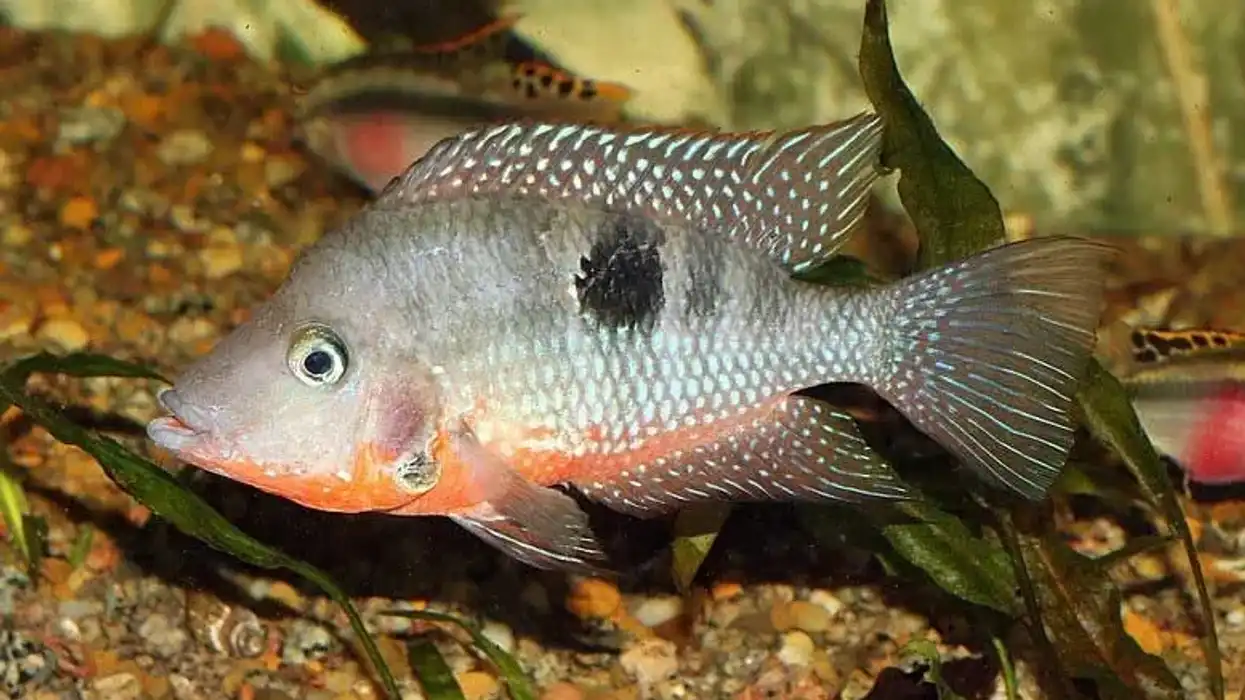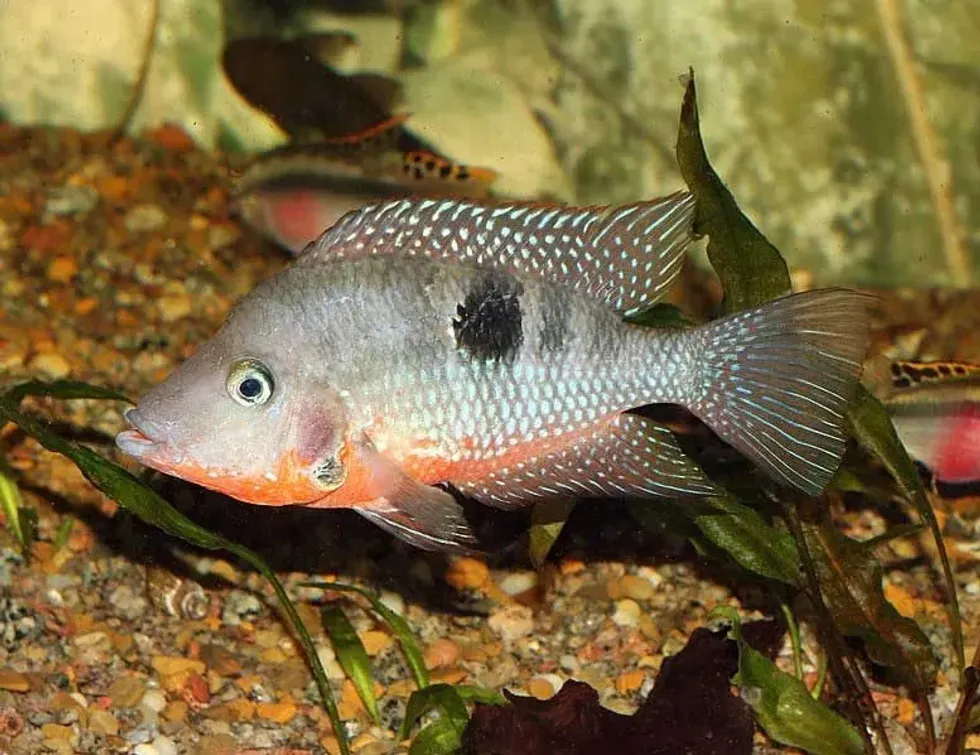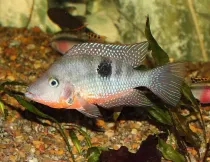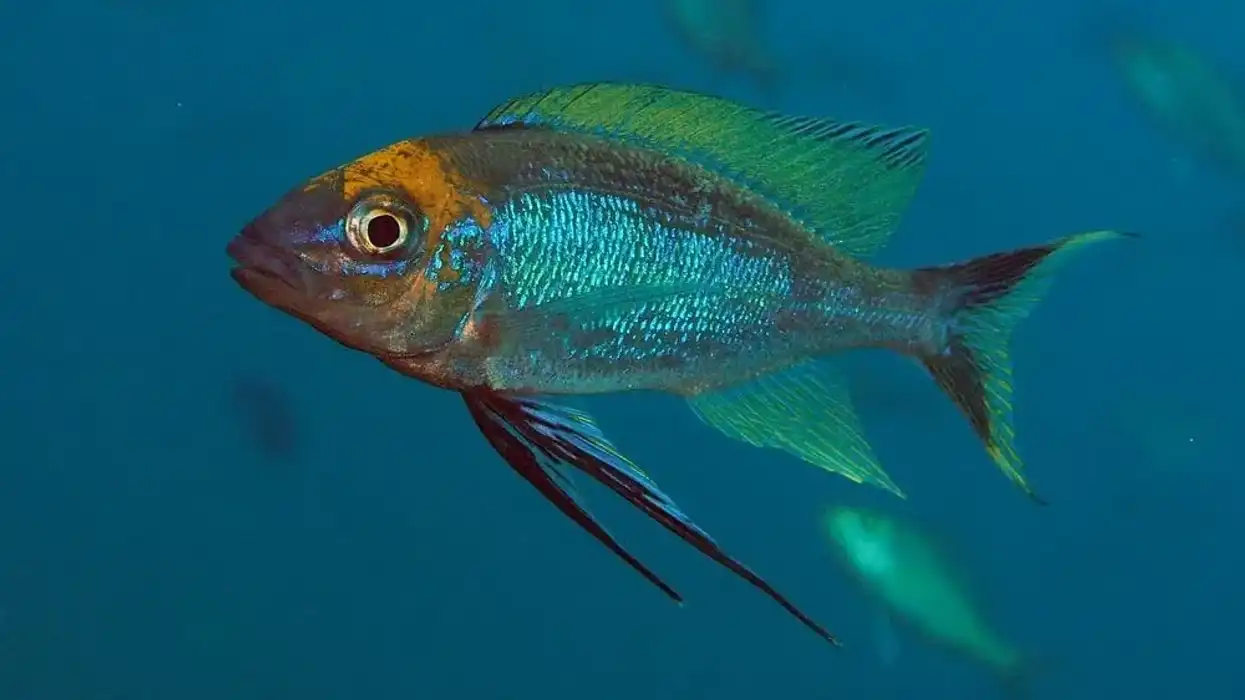Fun Firemouth Cichlid Facts For Kids

Content
- What type of animal is a firemouth cichlid?
- What class of animal does a firemouth cichlid belong to?
- How many firemouth cichlids are there in the world?
- Where does a firemouth cichlid live?
- What is a firemouth cichlid's habitat?
- Who do firemouth cichlids live with?
- How long does a firemouth cichlid live?
- How do they reproduce?
- What is their conservation status?
- What do firemouth cichlids look like?
- How cute are they?
- How do they communicate?
- How big is a firemouth cichlid?
- How fast can a firemouth cichlid swim?
- How much does a firemouth cichlid weigh?
- What are the male and female names of the species?
- What would you call a baby firemouth cichlid?
- What do they eat?
- Are they eaten by humans?
- Would they make a good pet?
- Did you know...
- Are firemouth cichlids aggressive?
- Is a firemouth cichlid territorial?
If you are looking for an interesting type of fish that is native to Central American rivers and streams, then you must read about the firemouth cichlid. This fish is part of the cichlid family of fish and are found in countries like Mexico, Panama, Belize, and Guatemala.
They were discovered in 1918 and the second part of their scientific name pays tribute to ichthyologist, Seth Eugene Meek.
They are thought to be slightly aggressive and inhabit the muddy, warm tropical streams of these countries.
They are also present globally because they are often exported to various countries as aquarium fish. However, countries like the United States have classified them as invasive fish because they have been observed to disturb the balance of the local fauna.
Continue reading if you want to find out more facts about this type of cichlid fish. If you are interested in other marine animals and creatures, take a look at skipjack tuna and freshwater drum.
Firemouth Cichlid Interesting Facts
What type of animal is a firemouth cichlid?
Firemouth cichlid (Thorichthys meeki) is a freshwater fish that is found in Central America. This tropical fish species is suitable as a tank or aquarium fish for beginners. They are one of the more popular cichlids found in the Central American region.
What class of animal does a firemouth cichlid belong to?
Firemouth cichlid (Thorichthys meeki) is a tropical fish that belongs to the class of Actinopterygii and the family Cichlidae. Actinopterygii class of fish are those that are ray-finned. All types of cichlids fall under the class of Actinopterygii.
How many firemouth cichlids are there in the world?
This freshwater fish species of firemouth cichlids is famous all over the world as tank fish. They are also found in abundance in the freshwater Central American rivers.
However, due to the lack of proper data on these cichlids, there are no estimates of the total population of these fish around the world. Yet, that shouldn't come as a worry because firemouth cichlid freshwater fish are in no imminent conservation danger.
Where does a firemouth cichlid live?
Firemouth cichlids are known to inhabit the rivers and streams of the Central American region. They are native to the rivers of the Yucatán Peninsula, El Salvador, Belize, Honduras, Costa Rica, Nicaragua, Panama, and northern Guatemala.
Apart from that, they can be seen in aquariums or as community tank fish all over the world. These cichlids are quite popular in the United States and have also been exported to countries like Singapore.
What is a firemouth cichlid's habitat?
The natural habitat of a firemouth cichlid is warm, tropical river water. They are found in rivers that are slow-moving and have sandy and muddy river beds.
Ideally for them, the water should be turbid with a pH balance between a range of 6.5-8.0. This fish species is also found to inhabit sunken cave systems where they enjoy greater protection from larger fish and marine animals.
Usually, firemouth cichlids are found between the middle and the bottom layers of the water, be it a river, an aquarium, or a tank.
In rivers, ponds, and streams, they are known to always stay near the vegetation so that they can easily feed on algae and other meaty substances. Behavior-wise, firemouth cichlids are not classified as schooling fish even though they might live near other cichlids and fish.
They are thought to be moderately territorial. For their temperament, semi-aggressive is how marine biologists would term them.
Who do firemouth cichlids live with?
Firemouths are not a species of schooling fish. They do not travel in huge numbers and are generally solitary.
Male and female firemouth cichlids are known to be monogamous and form nuclear families. Even in the setting of an aquarium or a tank, firemouth cichlids can make good tank mates with similar-sized fish. However, problems may arise when firemouth cichlids have smaller fish as their tank mates.
How long does a firemouth cichlid live?
Firemouth cichlids are known to live relatively long life. In the wild, a full-grown firemouth cichlid will live for around eight to 10 years.
The lifespan increases in captivity with an adult firemouth cichlid living up to 15 years with proper care and diet. However, their lifespan might be affected by fungal infections like mouth rot which can be quite painful for this fish.
How do they reproduce?
Spawning and reproduction are important parts of the firemouth cichlid lifecycle. In a manner that is akin to other cichlids, a female firemouth cichlid and a male firemouth cichlid make excellent parents.
These cichlids are known to take their time in finding a mate. Once they find a companion, they mate for life i.e. they are monogamous.
During the period of breeding and spawning, males of this semi-aggressive species are known to get very territorial. They quickly ward off and chase other males and fish who come near their territory during the breeding period.
Females have been observed to clean rocks where they lay eggs. One brood of eggs can have up to 100 to 500 eggs and once the egg is released, males fertilize them.
Once the eggs are fertilized, both males and females care for and guard their brood aggressively. Eggs hatch within 48 hours of fertilization and are usually nested in pits dug up in the substrate by the parent males and females.
While males of this freshwater species have the responsibility of guarding the pits and the firemouth cichlid babies, females have the duty of collecting food like brine shrimp and raising the firemouth cichlid fry.
Interestingly, the firemouth cichlid growth rate is quite rapid. As a result of this fast growth rate, the fry can become independent just weeks after their breeding and hatching procedures began.
Due to this phenomenon, males and females of this cichlid species can have multiple breeding periods and raise several broods throughout the year. Firemouth cichlid care procedures are often studied by marine biologists.
Breeding this fish in tank water or an aquarium can be tricky. Breeding shouldn't be forced but provided the tank size is adequately large, one can introduce up to six individuals of varying genders to get the fish to start breeding.
What is their conservation status?
Due to their abundance in the wild and popularity all over the world as aquarium tank mates and as a community fish, firemouth cichlids' population is in no danger of going down at present.
Therefore, this freshwater fish (firemouth cichlid) has been excluded from the Vulnerable categories in the Red List of the International Union For Conservation Of Nature or the IUCN.
This fish species is currently categorized as a Least Concern species.
Firemouth Cichlid Fun Facts
What do firemouth cichlids look like?
Firemouth cichlid fish have quite a few distinct physical features. They are highly compressed laterally with a sharp slopping head leading to their mouths. Like all cichlids, firemouths have a set of pharyngeal teeth along with their normal set of teeth.
Males and females of this fish species can be easily distinguished by the fact that males are generally larger than females, and have sharply pointed dorsal and anal fins. Apart from the pointed dorsal and anal fins, males are more bright in color and have a red marking under the region of their throat.
Females have the distinct feature of a blunt genital papilla, while males have a pointed one. A firemouth cichlid female has been observed to be rounder in shape due to a larger belly.
Their fish scales are beautiful to look at. The fiery red coloring of this fish runs from its mouth to the underside to the base of its tail. The common name for firemouth is derived from this distinct red coloration.
The body of this fish, on the other hand, is turquoise blue-greyish in color. This coloration is broken up by some blemishes or black blotches on the surface of the body. The fins have been noted to also have turquoise blue and metallic gray coloring.
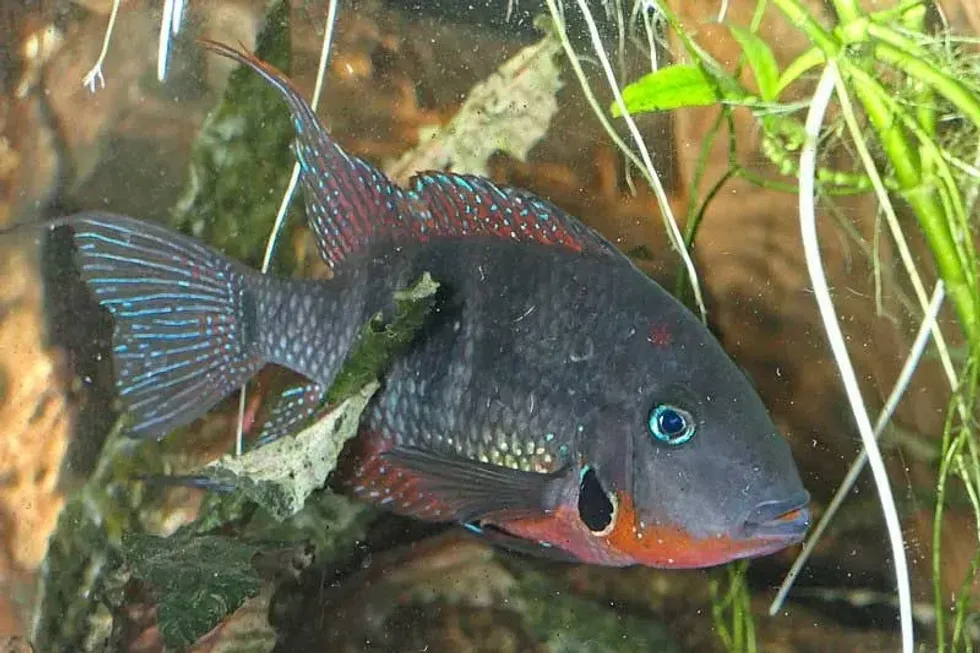
How cute are they?
With their beautiful coloration and adorable appearance, firemouth cichlids can come across as very cute and peaceful. However, you shouldn't let their appearances fool you because this fish can get quite aggressive when required.
Male fish of this type of cichlid is known to bloat their gills up to scare off predators or other males. This exposes the red color on their throats. When people watch this feature of the fish in action, they find it incredibly cute.
How do they communicate?
There is no significant research on how firemouth cichlids communicate with each other. Of course, we do know that there are certain physical actions and motions like flaring up of their gills that convey emotions such as aggression.
Yet, nothing more concrete is known about their communication mode. However, we can assume a few things about firemouth cichlids by taking the cichlids species as a whole.
Cichlids have been observed to communicate by changing the color patterns on their body. It can be safe to presume that firemouth cichlids do the same.
How big is a firemouth cichlid?
Firemouth cichlids are generally small fish with the average firemouth cichlid size ranging from around 6 in (15.24 cm). A large firemouth cichlid size is usually between 7-8 in (18-20.3 cm), and males are usually larger than females.
This is because sexual dimorphism exists between the genders with a male fish being much bigger than a female fish. Sometimes, interestingly cichlid fish born in an aquarium or a tank is smaller in length than those born in the wild. In comparison to trouts, cichlids are around half their length.
How fast can a firemouth cichlid swim?
Again, there is not much data and research available to determine the speed of firemouth cichlids, though there are some behavioral traits that will help us understand the swimming speed of this fish. The natural habitat of this fish is sand and muddy slow-moving water in tropical rivers.
This can help us conclude that firemouth cichlids do not have a high swimming speed. We can easily assume that they are fish who swim at a leisurely pace.
How much does a firemouth cichlid weigh?
Firemouth cichlids are not heavy at all with most reports placing their average weight to be near 0.22 lb (99 g). Their weight can be easily maintained with proper care and diet in captivity.
What are the male and female names of the species?
Firemouth cichlids do not have any distinct male and female names for their kind.
What would you call a baby firemouth cichlid?
Like all types of fish, a baby firemouth cichlid is simply known as the 'fry'. The fry has a high rate of growth and can consume food like brine shrimp as part of their diet. The fry is taken care of by both its parents.
What do they eat?
Being omnivorous, firemouth cichlids can eat a whole variety of things as part of their diet. Their primary diet includes small crustaceans, organic detritus, mollusks, and small invertebrates. They also often swim amidst algae looking for food.
While in tank captivity, a cichlid should be given healthy and nutritious food pellets and flakes along with occasional meaty treats of bloodworms. Vegetables like spinach and cucumber can also be given to them. Occasionally, cichlids eat the smaller fish in the tank.
Are they eaten by humans?
No, cichlids are not eaten by humans in general. This holds for firemouth cichlids as well.
Would they make a good pet?
Firemouth cichlids are generally suitable for an aquarium or a tank. They are quite cheap to get as well with one cichlid costing around $7.
Plus, a cichlid is easy to care for. For a firemouth cichlid, a community tank of a large size is recommended.
A firemouth cichlid tank size should be able to hold 30 gal (114 l) for a pair, however, the size of the tank needed will increase with the number of fish. Smaller fish are inappropriate as tank mates for the slightly bigger firemouth cichlids because they might be attacked or their fins nipped by the cichlid.
Suitable tank mates include swordtail, rummy nose tetra, bristlenose pleco, clown pleco, pictus catfish, and rainbow fish. However, African cichlids are not compatible with this species of cichlids.
Did you know...
Among the species of cichlid, firemouth cichlids are one of those that are used in behavioral studies.
Firemouth cichlids are known for having spiny rays on the rear portion of their dorsal, pelvic, anal, and pectoral. This helps them to ward off or scare predators. On the flip side, the forepart of these fins is soft and helps to make accurate movements in the water. However, these fins are not conducive for fast swimming.
Are firemouth cichlids aggressive?
Although they are peaceful fishes, firemouths cichlids are known to be semi-aggressive. Their aggression comes across especially during the spawning season where they become very defensive of their territories.
Male cichlids also fiercely protect their egg pits while the young ones hatch. They are also known to be invasive species in the United States because they supposedly destroy the natural fauna of places where they have been introduced. A Jack Dempsey cichlid is quite similar in aggression to this type of cichlid.
Is a firemouth cichlid territorial?
A male cichlid is very territorial during the breeding season. This is true both in the wild and in a tank habitat. If another fish approaches their territory during this time, a lot of aggression is shown by a male cichlid. However, firemouth cichlids can peacefully coexist with one another
Here at Kidadl, we have carefully created lots of interesting family-friendly animal facts for everyone to discover! Learn more about some other fish including blue tang, or blue catfish.
You can even occupy yourself at home by drawing one on our Firemouth Cichlid coloring pages.
We Want Your Photos!
More for You
Sources
https://en.wikipedia.org/wiki/Firemouth_cichlid
https://www.everythingfishkeeping.com/firemouth-cichlid/
https://fishtankadvisor.com/firemouth-cichlid/
See All
Bachelor of Arts specializing in Journalism and Mass Communication, Postgraduate Diploma in Sports Management

Moumita DuttaBachelor of Arts specializing in Journalism and Mass Communication, Postgraduate Diploma in Sports Management
A content writer and editor with a passion for sports, Moumita has honed her skills in producing compelling match reports and stories about sporting heroes. She holds a degree in Journalism and Mass Communication from the Indian Institute of Social Welfare and Business Management, Calcutta University, alongside a postgraduate diploma in Sports Management.
Bachelor of Science specializing in Computer Science

Chandan ShuklaBachelor of Science specializing in Computer Science
With a Bachelor's degree in Computer Science from Aryabhatta College, University of Delhi, Chandan is a skilled and passionate technophile. He has completed a machine learning training program and is adept in various programming languages. He has been working as a content writer for two years while also striving to become a proficient tech professional.
Disclaimer
1) Kidadl is independent and to make our service free to you the reader we are supported by advertising. We hope you love our recommendations for products and services! What we suggest is selected independently by the Kidadl team. If you purchase using the Buy Now button we may earn a small commission. This does not influence our choices. Prices are correct and items are available at the time the article was published but we cannot guarantee that on the time of reading. Please note that Kidadl is a participant in the Amazon Services LLC Associates Program, an affiliate advertising program designed to provide a means for sites to earn advertising fees by advertising and linking to Amazon. We also link to other websites, but are not responsible for their content.
2) At Kidadl, we strive to recommend the very best activities and events. We will always aim to give you accurate information at the date of publication - however, information does change, so it’s important you do your own research, double-check and make the decision that is right for your family. We recognise that not all activities and ideas are appropriate for all children and families or in all circumstances. Our recommended activities are based on age but these are a guide. We recommend that these ideas are used as inspiration, that ideas are undertaken with appropriate adult supervision, and that each adult uses their own discretion and knowledge of their children to consider the safety and suitability. Kidadl cannot accept liability for the execution of these ideas, and parental supervision is advised at all times, as safety is paramount. Anyone using the information provided by Kidadl does so at their own risk and we can not accept liability if things go wrong.
3) Because we are an educational resource, we have quotes and facts about a range of historical and modern figures. We do not endorse the actions of or rhetoric of all the people included in these collections, but we think they are important for growing minds to learn about under the guidance of parents or guardians.
